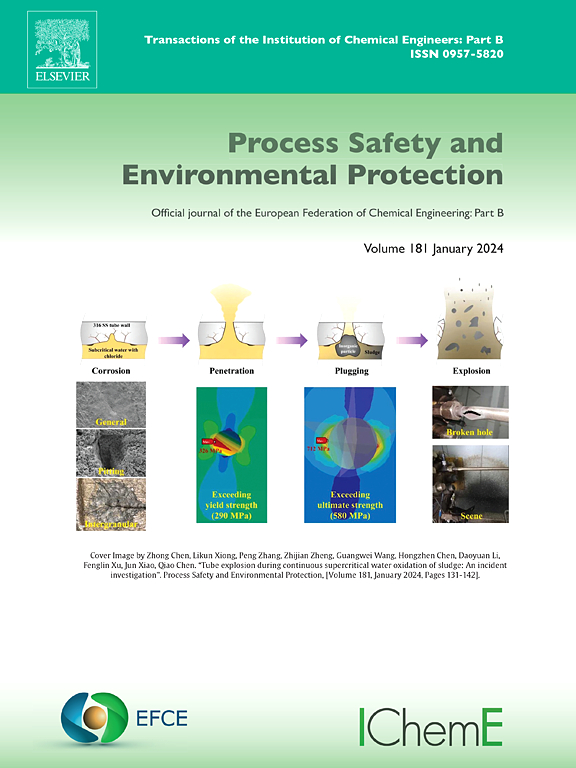中试规模高速率接触稳定初沉工艺处理能源中性废水
IF 7.8
2区 环境科学与生态学
Q1 ENGINEERING, CHEMICAL
引用次数: 0
摘要
本研究考察了在某高级生物污水处理厂(WWTP)实施的初级沉淀(PS+HiCS)中试规模高速率接触稳定(HiCS)工艺的有机碳去除性能和碳回收潜力。粒度室出水的COD分馏显示,颗粒、胶体和溶解COD分别为74.2%和24%。PS+HiCS工艺以1 m3/h的流速连续运行214天,srt从0.75到2天不等。接触槽(CT) hrt维持在23min,稳定槽(ST) hrt维持在72min。除CT故意保持不充气时SRT为0.63天外,两个槽内溶解氧(DO)浓度控制在1-3mg/L。总COD去除率达85%,氧化率降至12.5%。在SRT第1天,COD的捕获效率高达65%。在SRT为0.63天的情况下,该工艺显示出净能量增益潜力为0.32 kWh/m3,出水COD为100mg/L。本研究强调,使用拟议的PS+HiCS工艺可以以能源中性或能源正性的方式处理生活废水,为废水管理提供了可持续的解决方案。本文章由计算机程序翻译,如有差异,请以英文原文为准。
A pilot scale high-rate contact stabilization process with primary sedimentation for energy-neutral wastewater treatment
This study investigates the organic carbon removal performance and carbon recovery potential of a pilot-scale high-rate contact stabilization (HiCS) process with primary sedimentation (PS+HiCS), implemented at an advanced biological wastewater treatment plant (WWTP). COD fractionation of the grit chamber effluent revealed particulate, colloidal, and dissolved COD fractions of 74, 2, and 24 %, respectively. The PS+HiCS process was operated continuously at a flow rate of 1 m3/h for 214 days, with SRTs ranging from 0.63 to 2 days. HRTs were maintained at 23 min in the contact tank (CT) and 72 min in the stabilization tank (ST). Dissolved oxygen (DO) concentrations in both tanks were controlled at 1–3 mg/L, except for the SRT of 0.63 days when CT was intentionally kept non-aerated. A total COD removal efficiency of 85 % was achieved, and the COD oxidation reduced to 12.5 %. COD was captured with an efficiency of up to 65 % at 1 day of SRT. At an SRT of 0.88 days, the process demonstrated a net energy gaining potential of 0.32 kWh/m3 with < 100 mg/L effluent COD. This study highlights that domestic wastewater can be treated in an energy-neutral or energy-positive manner using the proposed PS+HiCS process, providing a sustainable solution for wastewater management.
求助全文
通过发布文献求助,成功后即可免费获取论文全文。
去求助
来源期刊

Process Safety and Environmental Protection
环境科学-工程:化工
CiteScore
11.40
自引率
15.40%
发文量
929
审稿时长
8.0 months
期刊介绍:
The Process Safety and Environmental Protection (PSEP) journal is a leading international publication that focuses on the publication of high-quality, original research papers in the field of engineering, specifically those related to the safety of industrial processes and environmental protection. The journal encourages submissions that present new developments in safety and environmental aspects, particularly those that show how research findings can be applied in process engineering design and practice.
PSEP is particularly interested in research that brings fresh perspectives to established engineering principles, identifies unsolved problems, or suggests directions for future research. The journal also values contributions that push the boundaries of traditional engineering and welcomes multidisciplinary papers.
PSEP's articles are abstracted and indexed by a range of databases and services, which helps to ensure that the journal's research is accessible and recognized in the academic and professional communities. These databases include ANTE, Chemical Abstracts, Chemical Hazards in Industry, Current Contents, Elsevier Engineering Information database, Pascal Francis, Web of Science, Scopus, Engineering Information Database EnCompass LIT (Elsevier), and INSPEC. This wide coverage facilitates the dissemination of the journal's content to a global audience interested in process safety and environmental engineering.
 求助内容:
求助内容: 应助结果提醒方式:
应助结果提醒方式:


